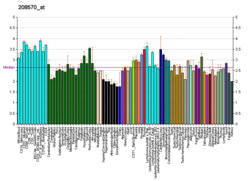Proto-oncogene Wnt-1, or Proto-oncogene Int-1 homolog is a protein that in humans is encoded by the WNT1 (INT1) gene.[5][6]
The WNT gene family consists of structurally related genes that encode secreted signaling proteins. These proteins have been implicated in oncogenesis and in several developmental processes, including regulation of cell fate and patterning during embryogenesis. This gene is a member of the WNT gene family. It is very conserved in evolution, and the protein encoded by this gene is known to be 98% identical to the mouse Wnt1 protein at the amino acid level. The studies in mouse indicate that the Wnt1 protein functions in the induction of the mesencephalon and cerebellum. This gene was originally considered as a candidate gene for Joubert syndrome, an autosomal recessive disorder with cerebellar hypoplasia as a leading feature. However, further studies suggested that the gene mutations might not have a significant role in Joubert syndrome. This gene is clustered with another family member, WNT10B, in the chromosome 12q13 region.[7]
See also
editReferences
edit- ^ a b c GRCh38: Ensembl release 89: ENSG00000125084 – Ensembl, May 2017
- ^ a b c GRCm38: Ensembl release 89: ENSMUSG00000022997 – Ensembl, May 2017
- ^ "Human PubMed Reference:". National Center for Biotechnology Information, U.S. National Library of Medicine.
- ^ "Mouse PubMed Reference:". National Center for Biotechnology Information, U.S. National Library of Medicine.
- ^ van Ooyen A, Kwee V, Nusse R (Jan 1986). "The nucleotide sequence of the human int-1 mammary oncogene; evolutionary conservation of coding and non-coding sequences". EMBO J. 4 (11): 2905–9. doi:10.1002/j.1460-2075.1985.tb04021.x. PMC 554596. PMID 2998762.
- ^ Arheden K, Mandahl N, Strombeck B, Isaksson M, Mitelman F (May 1988). "Chromosome localization of the human oncogene INT1 to 12q13 by in situ hybridization". Cytogenet Cell Genet. 47 (1–2): 86–87. doi:10.1159/000132513. PMID 3281802.
- ^ "Entrez Gene: WNT1 wingless-type MMTV integration site family, member 1".
Further reading
edit- McMahon AP, Moon RT (1990). "int-1--a proto-oncogene involved in cell signalling". Development. 107 Suppl: 161–7. doi:10.1242/dev.107.Supplement.161. PMID 2534596.
- Chance PF, Cavalier L, Satran D, Pellegrino JE, Koenig M, Dobyns WB (1999). "Clinical nosologic and genetic aspects of Joubert and related syndromes". J. Child Neurol. 14 (10): 660–666. doi:10.1177/088307389901401007. PMID 10511339. S2CID 38298436.
- De Ferrari GV, Moon RT (2007). "The ups and downs of Wnt signaling in prevalent neurological disorders". Oncogene. 25 (57): 7545–7553. doi:10.1038/sj.onc.1210064. PMID 17143299. S2CID 35684619.
- Thomas KR, Capecchi MR (1990). "Targeted disruption of the murine int-1 proto-oncogene resulting in severe abnormalities in midbrain and cerebellar development". Nature. 346 (6287): 847–850. Bibcode:1990Natur.346..847T. doi:10.1038/346847a0. PMID 2202907. S2CID 4341682.
- Turc-Carel C, Pietrzak E, Kakati S, Kinniburgh AJ, Sandberg AA (1988). "The human int-1 gene is located at chromosome region 12q12-12q13 and is not rearranged in myxoid liposarcoma with t(12;16) (q13;p11)". Oncogene Res. 1 (4): 397–405. PMID 3329717.
- Wang YK, Samos CH, Peoples R, Pérez-Jurado LA, Nusse R, Francke U (1997). "A novel human homologue of the Drosophila frizzled wnt receptor gene binds wingless protein and is in the Williams syndrome deletion at 7q11.23". Hum. Mol. Genet. 6 (3): 465–472. doi:10.1093/hmg/6.3.465. PMID 9147651.
- Bafico A, Gazit A, Pramila T, Finch PW, Yaniv A, Aaronson SA (1999). "Interaction of frizzled related protein (FRP) with Wnt ligands and the frizzled receptor suggests alternative mechanisms for FRP inhibition of Wnt signaling". J. Biol. Chem. 274 (23): 16180–16187. doi:10.1074/jbc.274.23.16180. PMID 10347172.
- Gazit A, Yaniv A, Bafico A, Pramila T, Igarashi M, Kitajewski J, Aaronson SA (1999). "Human frizzled 1 interacts with transforming Wnts to transduce a TCF dependent transcriptional response". Oncogene. 18 (44): 5959–5966. doi:10.1038/sj.onc.1202985. PMID 10557084. S2CID 2009505.
- Lee CS, Buttitta LA, May NR, Kispert A, Fan CM (2000). "SHH-N upregulates Sfrp2 to mediate its competitive interaction with WNT1 and WNT4 in the somitic mesoderm". Development. 127 (1): 109–18. doi:10.1242/dev.127.1.109. PMID 10654605.
- Tanaka K, Okabayashi K, Asashima M, Perrimon N, Kadowaki T (2000). "The evolutionarily conserved porcupine gene family is involved in the processing of the Wnt family". Eur. J. Biochem. 267 (13): 4300–4311. doi:10.1046/j.1432-1033.2000.01478.x. PMID 10866835.
- Tamai K, Semenov M, Kato Y, Kato Y, Spokony R, Liu C, Katsuyama Y, Hess F, Saint-Jeannet JP (2000). "LDL-receptor-related proteins in Wnt signal transduction". Nature. 407 (6803): 530–535. Bibcode:2000Natur.407..530T. doi:10.1038/35035117. PMID 11029007. S2CID 4400159.
- Mao J, Wang J, Liu B, Pan W, Farr GH, Flynn C, Yuan H, Takada S, Kimelman D (2001). "Low-density lipoprotein receptor-related protein-5 binds to Axin and regulates the canonical Wnt signaling pathway". Mol. Cell. 7 (4): 801–809. doi:10.1016/S1097-2765(01)00224-6. PMID 11336703.
- Kirikoshi H, Sekihara H, Katoh M (2001). "WNT10A and WNT6, clustered in human chromosome 2q35 region with head-to-tail manner, are strongly coexpressed in SW480 cells". Biochem. Biophys. Res. Commun. 283 (4): 798–805. doi:10.1006/bbrc.2001.4855. PMID 11350055.
- Semënov MV, Tamai K, Brott BK, Kühl M, Sokol S, He X (2001). "Head inducer Dickkopf-1 is a ligand for Wnt coreceptor LRP6". Curr. Biol. 11 (12): 951–961. Bibcode:2001CBio...11..951S. doi:10.1016/S0960-9822(01)00290-1. PMID 11448771. S2CID 15702819.
- Mizushima T, Nakagawa H, Kamberov YG, Wilder EL, Klein PS, Rustgi AK (2002). "Wnt-1 but not epidermal growth factor induces beta-catenin/T-cell factor-dependent transcription in esophageal cancer cells". Cancer Res. 62 (1): 277–82. PMID 11782388.
- Tice DA, Szeto W, Soloviev I, Rubinfeld B, Fong SE, Dugger DL, Winer J, Williams PM, Wieand D (2002). "Synergistic induction of tumor antigens by Wnt-1 signaling and retinoic acid revealed by gene expression profiling". J. Biol. Chem. 277 (16): 14329–14335. doi:10.1074/jbc.M200334200. PMID 11832495.




